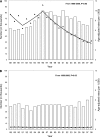Declining rates of hospitalization for nontraumatic lower-extremity amputation in the diabetic population aged 40 years or older: U.S., 1988-2008
- PMID: 22275440
- PMCID: PMC3263875
- DOI: 10.2337/dc11-1360
Declining rates of hospitalization for nontraumatic lower-extremity amputation in the diabetic population aged 40 years or older: U.S., 1988-2008
Abstract
Objective: To assess trends in rates of hospitalization for nontraumatic lower-extremity amputation (NLEA) in U.S. diabetic and nondiabetic populations and disparities in NLEA rates within the diabetic population.
Research design and methods: We calculated NLEA hospitalization rates, by diabetes status, among persons aged ≥40 years on the basis of National Hospital Discharge Survey data on NLEA procedures and National Health Interview Survey data on diabetes prevalence. We used joinpoint regression to calculate the annual percentage change (APC) and to assess trends in rates from 1988 to 2008.
Results: The age-adjusted NLEA discharge rate per 1,000 persons among those diagnosed with diabetes and aged ≥40 years decreased from 11.2 in 1996 to 3.9 in 2008 (APC -8.6%; P < 0.01), while rates among persons without diagnosed diabetes changed little. NLEA rates in the diabetic population decreased significantly from 1996 to 2008 in all demographic groups examined (all P < 0.05). Throughout the entire study period, rates of diabetes-related NLEA were higher among persons aged ≥75 years than among those who were younger, higher among men than women, and higher among blacks than whites.
Conclusions: From 1996 to 2008, NLEA discharge rates declined significantly in the U.S. diabetic population. Nevertheless, NLEA continues to be substantially higher in the diabetic population than in the nondiabetic population and disproportionately affects people aged ≥75 years, blacks, and men. Continued efforts are needed to decrease the prevalence of NLEA risk factors and to improve foot care among certain subgroups within the U.S. diabetic population that are at higher risk.
Figures
References
-
- Canavan RJ, Unwin NC, Kelly WF, Connolly VM. Diabetes- and nondiabetes-related lower extremity amputation incidence before and after the introduction of better organized diabetes foot care: continuous longitudinal monitoring using a standard method. Diabetes Care 2008;31:459–463 - PubMed
-
- Driver VR, Madsen J, Goodman RA. Reducing amputation rates in patients with diabetes at a military medical center: the limb preservation service model. Diabetes Care 2005;28:248–253 - PubMed
-
- Imperatore G, Cadwell BL, Geiss L, et al. Thirty-year trends in cardiovascular risk factor levels among US adults with diabetes: National Health and Nutrition Examination Surveys, 1971-2000. Am J Epidemiol 2004;160:531–539 - PubMed
-
- Hoerger TJ, Segel JE, Gregg EW, Saaddine JB. Is glycemic control improving in U.S. adults? Diabetes Care 2008;31:81–86 - PubMed
MeSH terms
LinkOut - more resources
Full Text Sources
Other Literature Sources
Medical


